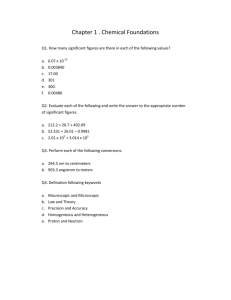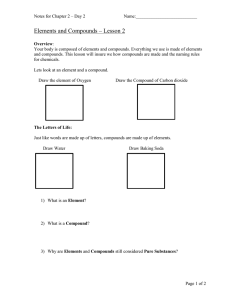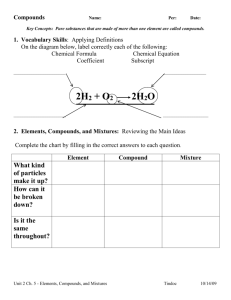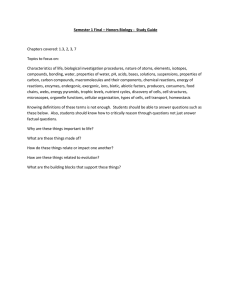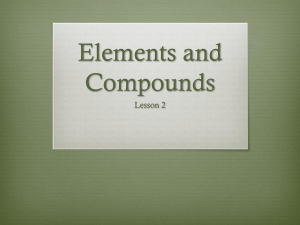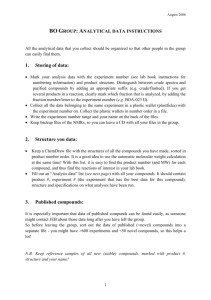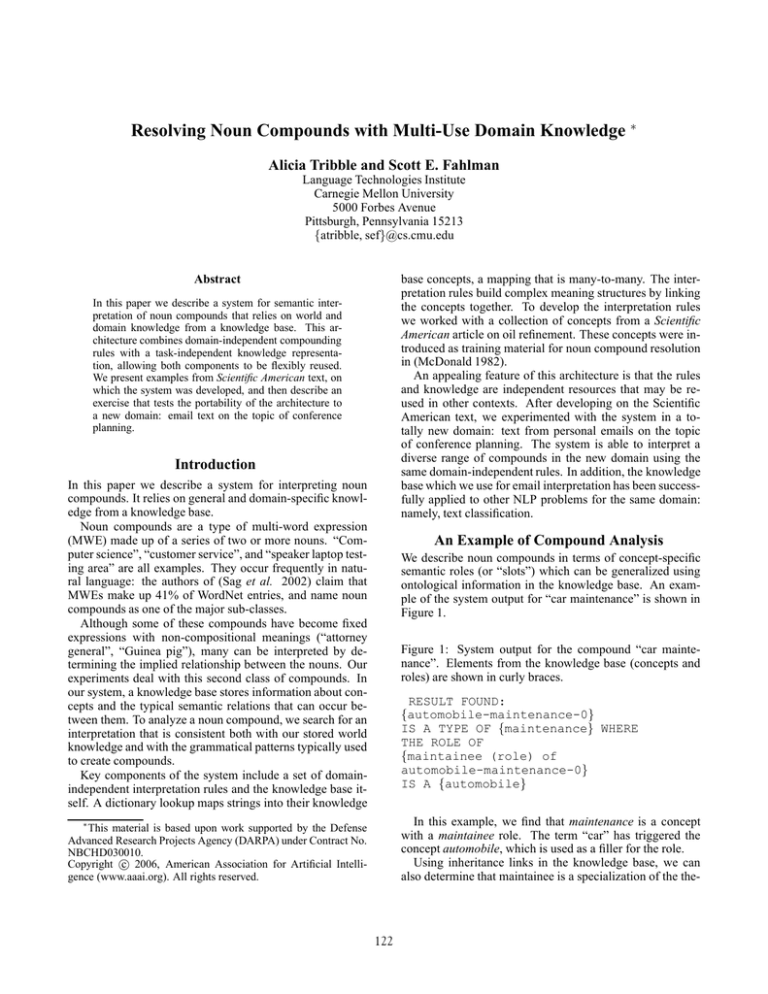
Resolving Noun Compounds with Multi-Use Domain Knowledge ∗
Alicia Tribble and Scott E. Fahlman
Language Technologies Institute
Carnegie Mellon University
5000 Forbes Avenue
Pittsburgh, Pennsylvania 15213
{atribble, sef}@cs.cmu.edu
base concepts, a mapping that is many-to-many. The interpretation rules build complex meaning structures by linking
the concepts together. To develop the interpretation rules
we worked with a collection of concepts from a Scientific
American article on oil refinement. These concepts were introduced as training material for noun compound resolution
in (McDonald 1982).
An appealing feature of this architecture is that the rules
and knowledge are independent resources that may be reused in other contexts. After developing on the Scientific
American text, we experimented with the system in a totally new domain: text from personal emails on the topic
of conference planning. The system is able to interpret a
diverse range of compounds in the new domain using the
same domain-independent rules. In addition, the knowledge
base which we use for email interpretation has been successfully applied to other NLP problems for the same domain:
namely, text classification.
Abstract
In this paper we describe a system for semantic interpretation of noun compounds that relies on world and
domain knowledge from a knowledge base. This architecture combines domain-independent compounding
rules with a task-independent knowledge representation, allowing both components to be flexibly reused.
We present examples from Scientific American text, on
which the system was developed, and then describe an
exercise that tests the portability of the architecture to
a new domain: email text on the topic of conference
planning.
Introduction
In this paper we describe a system for interpreting noun
compounds. It relies on general and domain-specific knowledge from a knowledge base.
Noun compounds are a type of multi-word expression
(MWE) made up of a series of two or more nouns. “Computer science”, “customer service”, and “speaker laptop testing area” are all examples. They occur frequently in natural language: the authors of (Sag et al. 2002) claim that
MWEs make up 41% of WordNet entries, and name noun
compounds as one of the major sub-classes.
Although some of these compounds have become fixed
expressions with non-compositional meanings (“attorney
general”, “Guinea pig”), many can be interpreted by determining the implied relationship between the nouns. Our
experiments deal with this second class of compounds. In
our system, a knowledge base stores information about concepts and the typical semantic relations that can occur between them. To analyze a noun compound, we search for an
interpretation that is consistent both with our stored world
knowledge and with the grammatical patterns typically used
to create compounds.
Key components of the system include a set of domainindependent interpretation rules and the knowledge base itself. A dictionary lookup maps strings into their knowledge
An Example of Compound Analysis
We describe noun compounds in terms of concept-specific
semantic roles (or “slots”) which can be generalized using
ontological information in the knowledge base. An example of the system output for “car maintenance” is shown in
Figure 1.
Figure 1: System output for the compound “car maintenance”. Elements from the knowledge base (concepts and
roles) are shown in curly braces.
RESULT FOUND:
{automobile-maintenance-0}
IS A TYPE OF {maintenance} WHERE
THE ROLE OF
{maintainee (role) of
automobile-maintenance-0}
IS A {automobile}
In this example, we find that maintenance is a concept
with a maintainee role. The term “car” has triggered the
concept automobile, which is used as a filler for the role.
Using inheritance links in the knowledge base, we can
also determine that maintainee is a specialization of the the-
∗
This material is based upon work supported by the Defense
Advanced Research Projects Agency (DARPA) under Contract No.
NBCHD030010.
c 2006, American Association for Artificial IntelliCopyright gence (www.aaai.org). All rights reserved.
122
matic role patient. This kind of information allows us to assign several labels to the noun compound relations, on varying levels of granularity. For the purposes of these experiments we always choose the most specific label possible. An
unordered list of the ancestors of maintainee of automobilemaintenance-0 is given in Figure 2.
concept definitions stored in the knowledge base. To store
and access these definitions we use the Scone Knowledge
Representation System (Fahlman 2005).
The Scone Knowledge Representation System includes a
representation language and an inference engine. The engine provides functions for adding new knowledge, and for
modifying or querying existing knowledge. Scone is opensource, and it also includes a small but growing collection of
core “common sense” facts. The work presented here is part
of our larger effort to acquire additional Scone knowledge
by understanding statements in Simple English.
Scone knowledge is stored in a semantic graph, where every concept is a Scone element. Scone can represent taxonomic information (“apple is a type of fruit”), as well as
role relations for objects (“a piece of fruit has seeds”) and
for actions (“eating has an agent and a thing-eaten”). Statements are also supported, and they may take other statements as arguments (“Sue believes that John owns this car.”).
During analysis of a noun compound, Scone provides a
list of role relations that are candidate labels for the compound (“{driving} is an {action} with a {driver (role)} and
a {vehicle (role)}”). Scone imposes selectional restrictions
on role fillers (“A {driver} must be a {person}”), and the engine provides an efficient mechanism to check for violation
of these restrictions.
Figure 2: Ancestors of maintainee of automobilemaintenance-0
{object affected (role)}
{manufactured product}
{automobile}
{wheeled-vehicle}
{vehicle}
{maintainee (role)}
{machine}
{participant (role)}
{physical object}
{tool}
{inanimate}
{thing}
Related Work
Several systems including (Finin 1980), (Leonard 1984),
and (Vanderwende 1994) have used a collection of semantic
concept representations with domain-independent combination rules. We share with these systems a focus on knowledge representation as a core technology for the task of compound resolution. The work of (Fan, Barker, & Porter 2003)
demonstrates that applying ontological knowledge makes
sense for this task, particularly in the context of knowledge
acquisition. In fact, an important effect of using representations from a knowledge base to interpret noun compounds
is that the results can be stored back in the ontology and applied to future tasks.
Our work expands most directly on the algorithms described in (McDonald 1982), We use an updated implementation of the knowledge base and interpretation algorithm,
and our goal is to broaden the applicability of the system by
testing and adapting to new text domains.
Empirical approaches have also become increasingly important for this task. Lauer (1995) compares several corpusbased techniques for bracketing noun compounds. Rosario
and Hearst (2001) cast the problem as a classification task,
and train a machine learning approach on hand-labeled examples from biomedical texts. In applications where domain
knowledge has not yet been created or collected, empirical
methods offer a good solution. In addition they often provide principled ways of ranking their results based on corpus
frequency. But Rosario and Hearst (2001), along with the
number of experiments combining empirical NLP systems
with WordNet (Fellbaum 1998), demonstrate that ontological knowledge helps when it is available. We describe some
ways to combine our approach with empirical analysis in the
section on Future Work.
Building The Domain Model
Knowledge bases are hand-coded in the representation language, and may be saved and loaded as independent subdomain models. For our examples, we have augmented a
general world-knowledge model by adding domain-specific
knowledge based on the development text. Our goal is to
establish the re-usability of domain knowledge and the interpretation algorithm, so we will first give some examples
from the development domain, and then describe how we
can apply the system to a new domain and re-use domain
knowledge in new tasks.
We begin by choosing a development set of noun compounds that employ a semantically diverse set of relations.
The development set described in (McDonald 1982) was our
starting point. A sample of these compounds is shown in
Figure 3. These compounds are all correctly interpreted by
the current system.
Our cross-domain core knowledge base includes 430
elements.
The upper levels of the ontology include
(among many others): {intangible}, {tangible}, {stuff},
{physical object}, {solid} {liquid} and {gas}, {animate},
{inanimate}, {person}, {animal} {plant}, {organization},
{time}. We build up domain knowledge on top of this reusable core. To cover the compounds in our target development set, we added 137 additional elements with rolestructures, bringing the total size of the knowledge base to
567 elements. This knowledge base is very small, but it
demonstrates our approach by being diverse enough to include a range of syntactic and semantic compound classes.
The scope of the knowledge base is important for the success of the algorithm because the vocabulary of noun compound relations that we can identify comes directly from the
Nominal Relations and the Knowledge Base
As the example above demonstrates, the relationship labels
we assign to compound nouns rely on the domain-specific
123
Compounds of Length Two
Figure 3: A Sample from the Development Set with their
Relations. When role relations are inherited from a supertype of the head noun, the supertype is also given.
For compounds of length two (N1 , N2 ), English word order usually places the head noun on the right (N2 ), with a
nominal pre-modifier on the left (N1 ). In this case, we can
drive the search for a semantic relation label with the following rule: examine the list of roles attached to N2 , and
determine which of these may be filled by N1 . Return all
licensed roles. This is the strategy which finds the meaning
of pickup truck in Figure 3. When this rule fails to return a
licensed meaning, the reverse word order may be tried: take
N1 as the head noun and search for roles that may be filled
by N2 . This strategy is necessary for analyzing car wheel,
also in Figure 3.
fuel economy
{fuel} fills {economize-what (role)}
oil production
{oil} fills {produces-what (role)}
underground oil
{underground} fills {source (role)} of a {material}
passenger car
{person} fills {transports-what (role)} of a {vehicle}
pickup truck
{pickup} fills {intended-use (role)} of a {tool}
car wheel
the {wheel} which is {part-of (role)} of a {automobile}
petroleum products
{petroleum} fills {composing-material (role)} of
{physical object}
oil embargo
{oil} fills {restricts-what (role)}
gasoline shortage
{shortage-of (role)}
oil imports
{Equality} of {imports-what (role)} and {oil}
automobile industry
{industrial-product (role)}
consumer preference
{who-prefers (role)}
Compounds of Length Three or More
Several systems treat the two-noun, left-to-right compound
as the basic case, and derive interpretations for longer compounds by recursively attaching left-hand nouns as modifiers
to the current right-hand head. Systems like (Barker & Szpakowicz 1998), on the other hand, use a trained model to
choose a bracketing first, then assign semantic labels to the
bracketed constituents afterward.
Our system is intermediate between these two, in that it
applies several additional rules to account for compounds of
length three or more, but does not consider all possible headmodifier bracketings. These rules build role-filler chains by
parsing from left to right (coal mine supervisor) or from
right to left (glass wine glass). There are also two special
rules for nominalized verbs, which are allowed to take subheads as fillers to their left and to fill roles to their right (tension adjustment screw).
The interpretation rules listed above are ordered, so that
they can be used to perform heuristic disambiguation. In
general the system applies all of the rules and delivers all
possible interpretations that are licensed by the knowledge
base and which fit any of the rules. When a single answer
is required, the higher-ordered rules fire first and the first
licensed interpretation is returned. For long compounds, this
rule ordering means that simple left-to-right head-modifier
bracketing is tried first. It is a priority in our future work to
add a more sophisticated selection mechanism for choosing
the best interpretation.
roles and statements that can join two nominal concepts in
the knowledge base.
Interpretation Rules
While the knowledge base provides a vocabulary of semantic relations along with some important constraints, as a generative source for semantic labels it will over-generalize.
For example, the knowledge base contains is-not-a links in
addition to is-a links. But behavioral research shows that
these relationships don’t occur in noun compounds (Downing 1977).
For this reason, the search for which relation holds in a
given compound is driven by interpretation rules. Our rules
are modeled on the cases described in (McDonald 1982),
and they impose an order of preference based on the syntactic structures that can occur in a compound.
Part of the difficulty in analyzing noun compounds is that
there are few syntactic cues. In fact, early linguistic literature on noun compounds (Lees 1960) describes them as a
deletion phenomenon, where the compound is the short form
for an entire relative clause: “A man who takes away the
garbage” becomes “garbage man.” However some syntax
does remain in the form of word order. Using a combination
of word order and the interpretation rules to drive our search,
we are able to recognize the difference between passenger
car and car passenger. More details are given below.
Re-using the Components
In an experiment to test the domain-independence of the interpretation rules, we tested the system on a number of example compounds from text in a new domain.
The Radar Email Corpus
Scone is currently in use as the knowledge representation
system for the Radar project (CMU-RADAR 2004). Radar
is a software tool that emulates a personal assistant; features
include scheduling, handling email and allocating resources
like conference rooms and video equipment. When a user
receives a new email, Radar labels it automatically with a
set of actions that the user may need to take in response.
The classifier that assigns these labels is an SVM trained on
124
pound analyzer at all. We also captured the phrase “head
start”, which we consider to be idiomatic. 7 of the remaining compounds were mis-labeled as noun compounds during test set extraction (Dear Blake, Mr. Robertson, Monday
night). 28 compounds did represent problematic cases for
our algorithm and are discussed below.
Figure 4: Example Compounds from Radar in Four Analysis
Cases
Event Title
Left-to-Right: a {title (role)} of an {event}
crowd control
Right-to-Left: {crowd} fills {controls-what (role)}
opening reception
Nominalized verb at start: {open} fills {purpose-of
(role)}
security request submission
Nominalized verb at end: {request} with {request-what
(role)} of {security} fills {submit-what (role)}
Example Output in the New Domain
Below are several examples of real system output for compounds in the Radar domain. In cases where the system has
to generate a new element to represent the compound, output includes an intermediate “RESULT FOUND” explanation. In cases where the compound meaning is interpreted as
a combination of existing nodes, there is only the final result
indicated by “MEANING:”.
lexical features of the email. It was implemented by the authors of (Klimt & Yang 2004) and uses a similar algorithm
to the one described there. Scone plays a role in the classification of emails by providing semantic features which
augment the lexical features in the classifier. The Scone analyzer for Radar does not include compound noun analysis.
Scone developers created a new knowledge base for the
Radar project. It models the relationships that are important in the domain of conference planning, which was a task
for users of Radar during recent evaluations. It includes instances of people and locations that occur in training emails,
collected semi-automatically. We refer to this knowledge
base as the Radar-kb. It contains more than 6,500 concepts
and instances.
“event title”
CHECKING PSEUDO ADJS
CONTEXT TOO GENERAL. REFUSING TO
FILL part ROLE.
NO LTR RELATIONSHIP. LOOKING RTL
MEANING: THE {conference event
title} OF A {conference event}
“crowd control”
RESULT FOUND: {crowd-control-0}
IS A TYPE OF {control} WHERE THE
ROLE OF
{controls-what (role) of
crowd-control-0}
IS A {crowd}
MEANING: {crowd-control-0}
Expansion of the Knowledge Base
This body of domain knowledge gives us the framework we
need to test the independence of our analysis rules. We have
hypothesized that the rules can be applied to text in any domain where we have sufficient knowledge. The Radar-kb
provides background knowledge for a new domain so that
we can test our hypothesis, and motivates our choice of test
corpus.
We have a corpus of emails that was used to train the
classifier described above. From these texts we automatically extracted a collection of 100 new noun compounds
which we use to test our analysis rules. First, we have to
augment the Radar-kb with concepts that occur in the noun
compounds. Only 30 of 282 vocabulary items in our collection had definitions in the Radar-kb. Without modifying
the analysis rules at all, we expanded the knowledge base by
hand to cover several examples from the new domain.
“opening reception”
RESULT FOUND: {event
opening-Reception-0}
IS A TYPE OF {Reception} WHERE THE
ROLE OF
{event purpose (role) of event
opening-Reception-0}
IS A {event opening}
MEANING: {event
opening-Reception-0}
“breakfast vendor”
RESULT FOUND: {conference
breakfast-vendor-0}
IS A TYPE OF {vendor} WHERE THE
ROLE OF
{provides-what (role) of conference
breakfast-vendor-0}
IS A {conference breakfast}
MEANING: {conference
breakfast-vendor-0}
Coverage of the Analysis Rules
In general, the analysis rules do capture a significant number
of the new compounds. Of the 100 new compounds we collected, 51 could be captured by straightforward role-filling
with either left or right bracketing. Three involved nominalized verbs. Example compounds covered by each of the four
rules are given in Figure 4.
11 of the remaining compounds were proper names of
companies or buildings, which have fixed meanings in the
knowledge base and do not need to be parsed by the com-
125
“security service request submission”
current rules focus on role fillers, and do not promote the
role names themselves as candidate interpretations.
An example from the subtype category is “banquet event.”
The proper interpretation is an {event} which is also a
{banquet}. Again, the focus on roles and fillers prevents
our system from finding the the meaning for this compound.
For this example, the system erroneously returns a {event}
which has a {sub-event} {banquet}.
This kind of error could be described as a pruning error:
we fail to consider the appropriate relation when searching
for connections in the knowledge base. The place to fix this
behavior is in the analysis rules.
RESULT FOUND: {security
service-request-0}
IS A TYPE OF {request} WHERE THE
ROLE OF
{request-what (role) of security
service-request-0}
IS A {security service}
RESULT FOUND: {security
service-request-0-submission-0}
IS A TYPE OF {submission} WHERE THE
ROLE OF
{submit-what (role) of security
service-request-0-submission-0}
IS A {security service-request-0}
MEANING: {security
service-request-submission-0-0}
Conclusions
We have presented a system for analyzing noun compounds
using a knowledge base. The system uses knowledge resources and domain rules that are independent of each other,
and can be re-used in new domains and NLP tasks. We have
given some successful examples in adapting knowledge developed for text classification to cover noun compounds, and
in applying the analysis rules to compounds from a new text
domain.
The problematic cases point to specific improvements that
we can make to the system. We should expand the analysis
rules to allow role names, and not just role fillers, to be considered during the search. We may also expand the rules to
allow compounds that join a supertype and subtype. However the prevalence of compounds that did fit into the rolefiller paradigm (51 out of the test set of 89) indicates that
such new rules should be tried only after our existing rule
set has been exhausted.
“NSF Conference”
RESULT FOUND: {nsf-conference-0}
IS A TYPE OF {conference} WHERE THE
ROLE OF
{sponsor (role) of
nsf-conference-0}
IS A {National Science Foundation}
MEANING: {nsf-conference-0}
“planning committee”
RESULT FOUND:
{planning-committee-0}
IS A TYPE OF {committee} WHERE THE
ROLE OF
{organizing purpose (role) of
planning-committee-0}
IS A {planning}
MEANING: {planning-committee-0}
Further Work
The knowledge in the Radar-kb was developed as a general domain model, and was further adapted with the task
of email classification in mind. This knowledge provided a
re-usable base for linking the new concepts that appear in
noun compounds in Radar email, although it did have to be
augmented with some vocabulary. We have not yet investigated re-usability of knowledge in the reverse direction:
could the concepts we added for noun compound analysis
improve performance of the email classifier? This is an experiment which we plan to conduct in the near future.
We will also continue to make improvements to the algorithm itself. In the current system, interpretation rules are
applied whenever possible and the result is a full list of licensed interpretations. The next step will be to add the ability to rank these interpretations. Both (Vanderwende 1994)
and (Finin 1980), for example, include a matching score for
the fitness of a role and filler pair. We are currently implementing automatic measures of semantic distance in Scone
that we will use in ranking role-filler matches, as well. This
will allow us to rank the resulting compound interpretations.
“committee headquarters”
MEANING: THE {headquarters (role)}
OF A {committee}
“planning committee headquarters”
MEANING: THE {headquarters (role)}
OF A {planning-committee-0}
Problematic Cases
There were 28 compounds in the collection we extracted
which do not fit into our current analysis paradigm and point
to improvements that we can make to the system. They fall
into two groups: compounds where the head noun is the
name of a role (rather than a role filler) for the modifier,
and compounds where the modifier is actually a subtype of
the head noun. An example from the role-name category is
“event location.” The proper interpretation is a role itself,
without any filler: the {location (role)} of an {event}. The
References
Barker, K., and Szpakowicz, S. 1998. Semi-automatic
recognition of noun modifier relationships. In Proceedings
126
of the 36th Annual Meeting of the Association for Computational Linguistics and 17th International Conference on
Computational Linguistics.
CMU-RADAR.
2004.
Radar project homepage.
http://www.radar.cs.cmu.edu/external.asp.
Downing, P. 1977. On the creation and use of english
compound nouns. Language 53(4):810–842.
Fahlman, S. E.
2005.
Scone User’s Manual,
http://www.cs.cmu.edu/∼sef/scone .
Fan, J.; Barker, K.; and Porter, B. W. 2003. The knowledge required to interpret noun compounds. In IJCAI 2003,
1483–1485.
Fellbaum, C., ed. 1998. WordNet An Electronic Lexical
Database. MIT press.
Finin, T. 1980. The semantic interpretation of nominal
compounds. In Proceedings of the First Annual National
Conference on Artificial Intelligence (AAAI-80).
Klimt, B., and Yang, Y. 2004. Email folder classification
using threads. In submitted.
Lauer, M. 1995. Corpus statistics meet the noun compound: Some empirical results. In Proceedings of the 33rd
annual meeting on Association for Computational Linguistics, 47–54. Morristown, NJ, USA: Association for Computational Linguistics.
Lees, R. B. 1960. The Grammar of English Nominalizations. Bloomington: Indiana University Press.
Leonard, R. 1984. The Interpretation of English Noun
Sequences on the Computer. Amsterdam: North-Holland.
McDonald, D. B. 1982. Understanding noun compounds.
Technical Report CMU-CS-82-102, Department of Computer Science, Carnegie Mellon University.
Rosario, B., and Hearst, M. 2001. Classifying the semantic relations in noun compounds. In Proceedings of the
2001 Conference on Empirical Methods in Natural Language Processing.
Sag, I. A.; Baldwin, T.; Bond, F.; Copestake, A. A.; and
Flickinger, D. 2002. Multiword expressions: A pain in
the neck for NLP. In CICLing ’02: Proceedings of the
Third International Conference on Computational Linguistics and Intelligent Text Processing, 1–15. London, UK:
Springer-Verlag.
Vanderwende, L. 1994. Algorithm for automatic interpretation of noun sequences. In Proceedings of the 15th
conference on Computational linguistics, 782–788. Morristown, NJ, USA: Association for Computational Linguistics.
127

